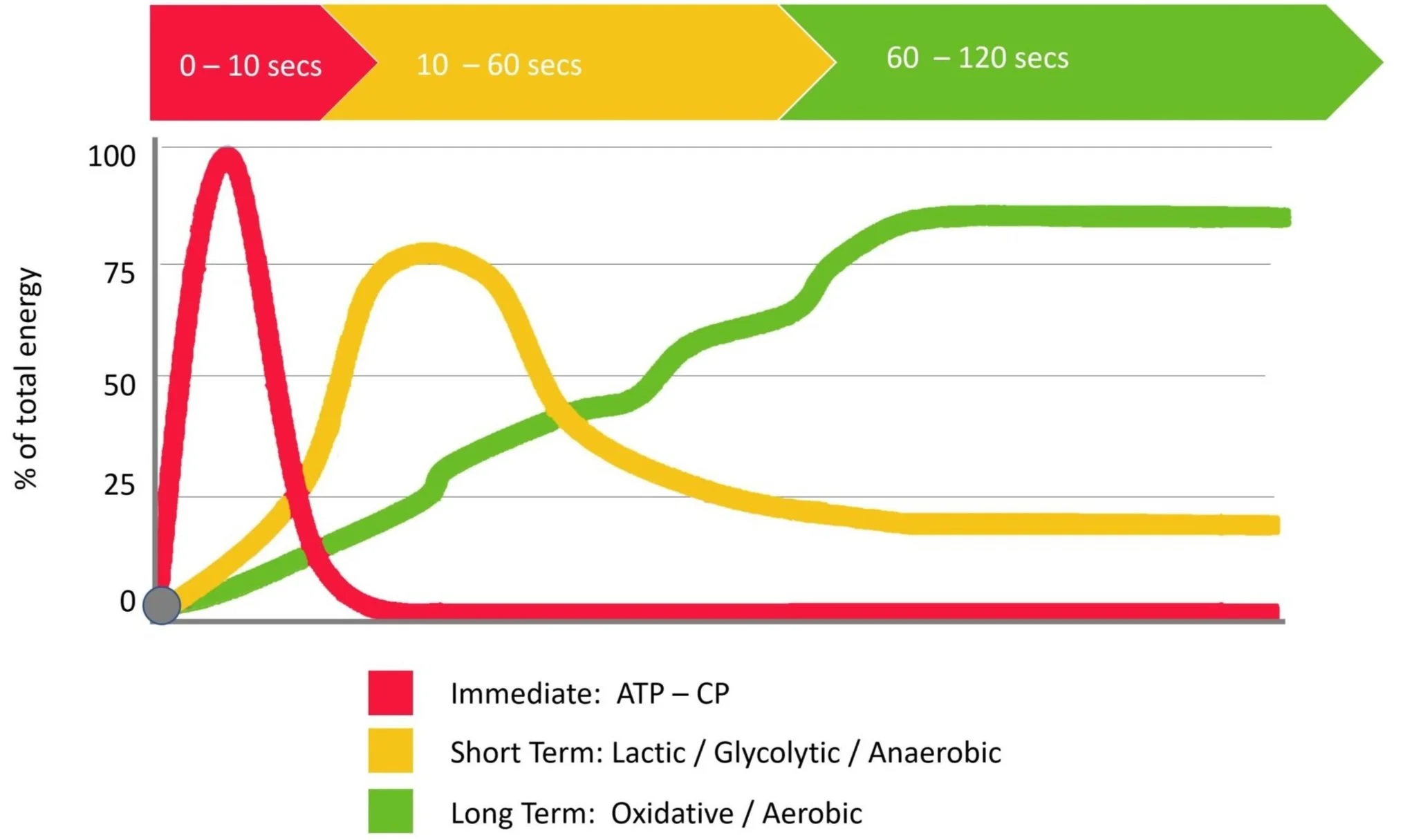An Introduction To Energy Systems: How Do Our Bodies Fuel Movement?
My previous post on the benefits of HIIT training briefly mentioned the concept of energy systems and how they each function efficiently at varying intensities and durations of exercise. Today, we break new ground. Today, we peek into the science behind how our bodies produce energy.
There are multiple means through which our bodies power movement with the materials we digest, mainly glucose. There are also countless sub-processes, enzymes and catalysts involved in these systems and “energy pathways” that I won’t bore you with. If you want to learn every small detail, head to a library and get a physiology textbook that features it all; it’ll weigh more than a house brick.
My aim here is to give you an overview of the features of each energy system, when they are most active and how we, as coaches; athletes; and general members of the population, can go about improving the capacity of these systems.
One at a time? Not quite
There’s no point where any of these systems works exclusively. While the intensity and duration of exercise will determine which energy system is the predominant source of power, they are always working in conjunction. Only the ratio in which energy is sourced from each will change. We can look at the graph below to understand how these energy systems interact at different exercise durations
Image Credit: Metrifit.com
What is ATP?
Adenosine Triphosphate, or ATP, is often referred to as the “energy currency” that is used in all of our cellular processes. Being an adenosine molecule with three phosphate groups attached, ATP stores energy in the bonds between the phosphate groups.
When ATP is used, a phosphate group is broken off, it releases energy and the adenosine triphosphate has now become adenosine diphosphate (ADP). The job of the energy systems that we will look at is to resynthesize ADP into ATP so that the cycle can begin again.
The Aerobic System
The aerobic energy system, also known as the oxidative pathway, is the only energy system in which the synthesis of ATP requires the presence of oxygen. It is very simple in concept, with the inputs being oxygen and glucose (a type of sugar, sourced from foods), and outputting ATP, Carbon Dioxide (CO2) and Water (H20).
Aerobic energy production is only effective at lower intensities of exercise and is dependent on the cardiovascular system’s capacity to deliver oxygen to the working muscles. This energy system is also renowned for having a “startup” time before it can produce energy maximally. This startup period is where the body goes through acute adaptations to exercises, when blood vessels start to widen (a process called vasodilation), heart rate and stroke volume (the amount of blood pushed out per beat) increase to enlarge cardiac output (the total volume of blood pushed out of the heart per minute).
The other two energy systems mentioned in this post have their respective time limits. The aerobic system, however, can power exercise indefinitely. The aerobic energy system is the main power supplier for endurance events such as marathons, triathlons and their respective ultra versions like Ironman events (2.4-mile swim, 112-mile bike, 26.2-mile run) and Ultra-Marathons which can cover over 100 miles. The limiting factors are the availability of glucose to fuel aerobic energy production and other requirements for the body such as hydration and electrolyte balance.
Anaerobic Glycolysis
Anaerobic glycolysis, also known as the “lactic acid” system, can synthesize ATP without the presence of oxygen. This system will become the primary source of energy when the intensity of exercise is too high to be met by the aerobic system, but the duration is too long to be sustained by the ATP-Pc system (mentioned later).
The main waste product of this energy system is lactic acid, which can accumulate and result in muscle fatigue, this is the “burn” towards the end of an exercise set. If lactic acid can be cleared away from the site where it is created faster than it is being produced, this burning sensation will not occur. The point where lactic acid production exceeds the rate at which it is removed is called the lactate threshold.
Anaerobic glycolysis is the key player in events such as 400m and 800m running, 1km time-trial track cycling, 100m and 200m freestyle swimming, and other events that typically take between 30 seconds and 3 minutes.
Phosphocreatine/ATP-Pc System
The Phosphocreatine system is brilliant at powering explosive movements. Examples of sports that are reliant on this include weightlifting; powerlifting; 100m sprint; and high jump.
Phosphocreatine (Pc) is a phosphorylated version of creatine (it has a phosphate group attached). When ADP is also present, the phosphate group can be transferred from Pc to the ADP and form ATP (with creatine left over). This ATP, as mentioned earlier, is the energy currency of our bodies.
Although it can fuel the most instantaneous and powerful muscle contractions of the three energy systems, it can only do so for about 10-12 seconds before the phosphocreatine stores in the muscle cells are depleted. It takes 3-5 minutes for these stores to “recharge”.
The End.
Thanks for reading.
Did you enjoy this blog post? Do you have any questions after reading it? Feel free to comment with any feedback and questions you may have in the comment section of this post or send your queries to me via email, social media, or the contact page on this website.

